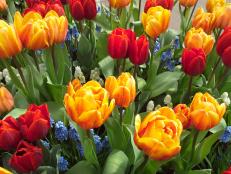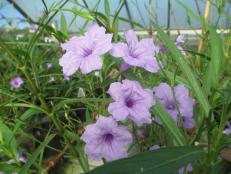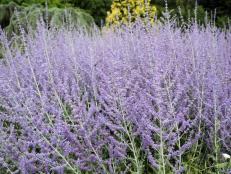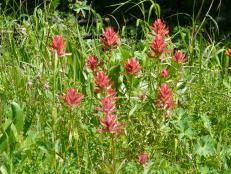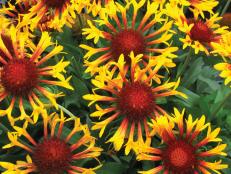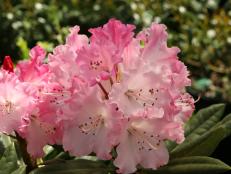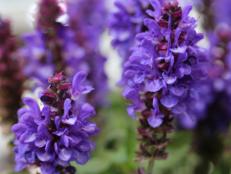Ginger Lily: Planting and Caring for Butterfly Ginger
Bring a touch of the tropics to your late summer garden with ginger lily, also known as butterfly ginger — a time-honored plant with flowers that smell like heaven.

Shutterstock/Nikolay Kurzenko
White ginger lily (Hedychium coronarium).

Ginger lily is a Southern classic that has been in gardens for generations.
It brings tropical pizzazz to your yard in the later summer and early fall when not much else is blooming. Ginger lilies are not true lilies, but instead are a distant cousin of gingerroot that’s used in cooking. Ginger lilies are not edible, though. You grow them for their fabulous tropical flowers.
Native to tropical Asia, ginger lilies became extremely popular in the 19th century when those original houseplant lovers, the Victorians, grew them in conservatories. Ginger lilies fell out of favor when rising heating costs made heating greenhouses full of exotic tropical plants expensive.
Fast forward about a century. A Kew Gardens botanist, Tony Schilling, rediscovered ginger lilies in 1965 during a trip to Nepal. He collected some specimens, brought them home to England, and plant breeders got to work breeding cold-hardy cultivars of the ginger lily. There are now more than 100 ginger lily cultivars on the market. The white ginger lily (Hedychium coronarium) is the one most commonly found in nurseries and at mom-and-pop plant sales.
Ginger Lily 101
Ginger lily has graceful, orchid-like blossoms that remind some people of butterfly wings, hence its nickname, butterfly ginger. Their blooms can be yellow, peach, white or orange. They have a sweet scent that’s a bit like honeysuckle. They make excellent cut flowers. A vase of ginger lilies will perfume a room for as long as a week. Ginger lily blooms are used to make leis in Hawaii, so they’re the ultimate tropical bloom.
Butterflies love slurping their nectar, so ginger lily is a great choice for a pollinator garden. Ginger lily is a deciduous perennial that dies back to the ground in the winter in Zones 8 to 10. If you live farther north, you’ll need to grow ginger lily as a houseplant and bring it indoors for the winter.
Depending on the type, ginger lily grows to 3 to 6 feet in height and 3 to 5 feet wide.
Botanical Name: Hedychium sp.
Common Name: Ginger lily
Other Names: butterfly ginger, white ginger, garland flower
Hardiness Zones: 8 to 11
Bloom Time: August and September
Growing Ginger Lilies
You can grow ginger lily from seed, a transplant, or from a rhizome — that’s a chunk of root. You’ll get blooms a lot faster from a rhizome or transplant than seed. Plants grown from seed won’t bloom for at least two years.
You can get ginger lily plants or rhizomes from nurseries or from online sellers. Ginger lily is a popular passalong plant because it spreads so quickly that it’s easy to share. Your gardening pals may be able to dig up some of their ginger lily and share it with you.
When to Plant Ginger Lily
- Early spring or fall are the best times to plant a ginger lily. Cooler temperatures make a less stressful environment for the plant and give it time to get established before summer heat sets in.
Where to Plant Ginger Lily
- Ginger lilies thrive in light shade, so plant them where they get no more than 4 hours of sun a day. They’ll tolerate full sun, but they’ll look a bit ragged.
- They need moist, well-drained soil. They look their best in soil that’s consistently moist or even wet. They love the edge of a stream or pond.
- You can grow them in containers or in the garden or yard. If you live in a zone north of 7B, it’s best to grow them in containers so you can bring them indoors for the winter.
Caring for Ginger Lilies
- Ginger lilies need consistent moisture to look and grow their best. Water a newly transplanted lily several times a week. Keep the soil evenly moist but don’t overwater.
- In cold climates (colder than Zone 7B) dig up the ginger lily rhizomes in later summer, after they bloom. Brush off the soil and store them indoors in paper bags in a cool, dry place. Replant in early spring.
- Fertilize ginger lily in the spring.
- Cut off spent flower blooms so the plant’s energy goes to feed its roots.
- Ginger lily spreads through its roots. You’ll need to divide them every few years to prevent overcrowding. In tropical climates, ginger lily can be invasive, so if you live in Hawaii or Rio de Janeiro, keep your ginger lily in check by digging some of it up and sharing it with friends.

Image courtesy Plant Delights Nursery, www.plantdelights.com
Hedychium 'Pradhanii' is a ginger lily hybrid from India. The pale, peach-colored flowers last from late summer until frost and carry a slight honeysuckle scent.
How to Propagate Ginger Lily
- Ginger lily can be propagated from seeds or by dividing rhizomes. Rhizomes are the most common way to grow them.
- To divide rhizomes, dig up clumps of the ginger lily and divide the rhizomes with a knife or spade. Make sure each chunk of rhizome has a growing shoot.
- Plant rhizome in a container or in the garden. Plant shoots will grow from the rhizome.
Pests and Diseases
- Ginger lily isn’t affected by any serious pest and diseases. It’s a hardy plant. It is susceptible to the usual garden problems of aphids, spider mites, scale and root rot.
Recommended Ginger Lily Cultivars
‘Cream Garland’ (Hedychium flavescens) is super tropical and hardy only in Zones 9 to 11. Its blooms are pale lemon yellow on 2-foot spikes. Grows to 6 feet tall and 3 feet wide.
‘White Ginger Lily’ (Hedychium coronarium) is the classic ginger lily of old Southern gardens. It reaches 5 feet in height and produces white sprays of white flowers from late summer to early fall.
‘Daniel Weeks’ (Hedychium 'Daniel Weeks') This cultivar produces golden-yellow blooms and is cold-hardy to Zone 7B, so it’s more resistant to a chill than other ginger lilies. It’s also one of the longest flowering of the ginger lilies, producing blooms from July to first frost. Grows to 4 feet tall.
‘Raffillii’ (Hedychium 'Raffillii') Introduced in 1941, this cultivar has a rep for being one of the finest ginger lilies ever bred. It reaches 6 feet in height and produces 18-inch spikes of brilliant orange flowers
Fun Fact
White ginger lily (Hedychium coronarium) is the national flower of Cuba.






